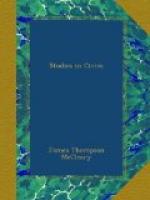Can you see the relation of these facts to the generalization? Can you tell where the people of the two sections of the state came from?
PART II.
THE STATE.
CHAPTER IX.
WHY WE HAVE STATES.
1. Historical reason. We have states now because we had such organizations at the time this government was established. The colonies, founded at different times, under different auspices, by people differing in religion, politics, and material interests, remained largely independent of each other during colonial times, and on separating from England became independent states.
2. Geographical reason. Different climatic and topographic conditions give rise to different industries, and therefore necessitate different regulations or laws.
3. Theoretical reason. The theory of our government is that of decentralization of power.[Footnote: There being a constant tendency to centralization, this thought should be emphasized. See Nordhoff’s Politics for Young Americans. (71)] That is, we think it best to keep power as near as possible to the people. If a certain work can be accomplished fairly by individual enterprise, we prefer that it be done so rather than through any governmental agency. If work can be done by the town just as well as by the county, we assign it to the town. And as between the state and the general government, we assign no duty to the latter which can be performed as well by the former.
4. Practical reasons. There are many practical reasons. Among them may be mentioned the following:
We need the state as a basis for the apportionment of members of congress. This is a federal republic, and representation in the national councils can be had only through statehood.
We need the state to establish a system of education, to control corporations, to put down riots when the local authorities cannot do so, to establish the smaller organizations, etc. These are some of the things referred to in paragraph three, which the state can do better than the general government.
There is in the state also a high court of justice to which cases may be appealed from the courts below.
HOW STATES ARE CREATED.
The “old thirteen” originated in revolution. They declared themselves “free and independent states,” and maintained the declaration by force of arms. Each became a state “in the Union” by ratifying the constitution. Under the constitution states have been admitted into the Union on terms prescribed by congress. The plan in general is as follows:
1. When the number of people in a territory equals or nearly equals the number required to secure a representative in congress, the inhabitants thereof may petition congress, through their delegate, for an act authorizing the formation of a state government.




